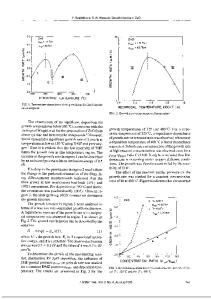Nanocrystalline Zirconia Ceramics and Films Prepared by Chemical Vapor Synthesis and Deposition
- PDF / 520,722 Bytes
- 5 Pages / 612 x 792 pts (letter) Page_size
- 73 Downloads / 386 Views
Nanocrystalline Zirconia Ceramics and Films Prepared by Chemical Vapor Synthesis and Deposition Johannes Seydel1, Markus Winterer, Horst Hahn Darmstadt University of Technology, Institute of Materials Science, Petersenstrasse 23, 64287 Darmstadt, Germany 1 E-mail address: [email protected] ABSTRACT We have prepared thin yttria-stabilized zirconia (YSZ) electrolyte layers by chemical vapor deposition (CVD) on a pre-sintered NiO/YSZ fuel cell anode substrate. Structural analysis by scanning electron microscopy (SEM) and x-ray-diffraction shows a homogeneous, nanocrystalline layer. Conventional electrolyte films reach desired electrical properties only at elevated temperatures, typically 1000°C to 1100°C. The YSZ films grown by CVD on rough anode substrates show better growth behavior and less defects at the anode/electrolyte interface than films deposited by conventional methods (screen printing, sol-gel). Results of electrical properties at lower SOFC working temperatures are obtained by impedance spectroscopy on pressed nanocrystalline YSZ powder pellets produced by chemical vapor synthesis (CVS) .
INTRODUCTION Zirconia, stabilized by 8 mol% yttria (YSZ) is today’s most important electrolyte material in solid oxide fuel cells (SOFC), because of its good oxygen ion conductivity and thermal stability. However, the lifetime of a SOFC is often limited by diffusion processes between its different components during the operation. Reducing the operating temperature will then increase the lifetime of the SOFC system due to the temperature dependence of diffusion processes, and allows the use of less expensive materials for interconnect, heat exchanger and other structural components [1]. The problem of lower operating temperatures is the decrease of the electrolyte conductivity. This can be solved by reducing the electrolyte thickness. However, with decreasing thickness, the gas permeability of conventional materials is becoming a problem, because grain sizes in the range of the desired layer thickness of a few microns could not assure the low gas permeability necessary to prevent both fuel and oxidant to permeate through the electrolyte and cause cell shortage. In conventional ceramic processing methods, high sintering temperatures in the production step of the electrolyte layer will cause grain coarsening of electrode materials, especially of the anode functional layer. Using nanocrystalline materials it is possible to produce a thin layer with low gas permeability and grain sizes that are at least one order of magnitude smaller than the layer thickness. In this paper, we present results on nanocrystalline electrolyte layers synthesized with chemical vapor deposition and densified nanocrystalline powders produced by chemical vapor synthesis.
Y8.14.1
EXPERIMENTAL DETAILS The unique CVD/CVS facility developed at the Institute of Materials Science at Darmstadt University of Technology allows the synthesis of both nanocrystalline films and nanocrystalline powders. Film growth in CVD/CVS, occurs by the simultaneous de
Data Loading...









